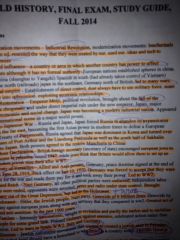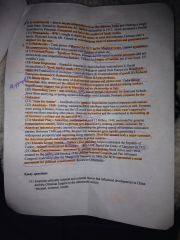![]()
![]()
![]()
Use LEFT and RIGHT arrow keys to navigate between flashcards;
Use UP and DOWN arrow keys to flip the card;
H to show hint;
A reads text to speech;
8 Cards in this Set
- Front
- Back
|
Modernization Movements
|

|
|
|
Sphere of Influence
|
When one country has the ability to control the development of another country even though they don't have any formal authority
|
|
|
Decolonization Process in India and South Africa
|
World wars weakened Europe and US and USSR opposed European colonial empires. Ideal of national determination
India Indian identity, British media, Indian national congress 1885, Mohandas Gandhi led reforms, effort to mobilize women, divide between Muslim and Hindu, Pakistan. 1947 South Africa Nelson Mandela led reforms similar to Gandhi, black majority had no power, dependent of the white upper class, creation of African National Congress in 1912, women's protests. Black consciousness. 1994 Why the evolved diff. India sought independence from European countries while South Africa sought it from the white minority. India was based on religion and SA was based on Race. India was among first, SA was among last. |
|
|
Approaches to socialism. China and USSR
|
Landlords
China Mao Zedong 1950-60, communists established Russia as an ally, trained teams of poorer peasants to go out and humiliate landlords. It was firmly rooted in the rural areas and was popular among peasants. Population was greater. Peaceful collectivism in ag industry. Close connection between Chinese communism and peasants. USSR Joseph Stalin 1920-30. Russian Bolsheviks faced hostile capitalist world alone. Peasants spontaneously redistributed land. Based in cities, literacy and modern Ed. was less developed. Peasants were fired into collective farms. Violence extensive. Stalin singled out richer peasants (called kulaks) for exclusion from the farms. |
|
|
Developments in China and the Ottoman Empire in the 19th Century
|
China
Population growth, pressure on land, Taiping Uprising, central state lost power. Opium wars, British smuggled in opium from India, treaty of Nanjing ended first war. Summer palace destroyed. Boxer Uprising 1898-1901, rural social economic structure structure restored. Society of Righteous and Harmonious Fists. Traditional gender roles questioned. 100 days of reforms failed 1898 Ottoman Defensive modernism. Weak central state. Janissaries became highly conservative force. Riots protesting foreign imports. Agreements that granted westerners various exemptions from law and taxation. Nationalist revolts. Other countries took control, eur. Penetration of economy. Britain and Russia supported independence seeking countries. Egypt nearly caused collapse. Dm, sultan selim 3 tried to reform. Janissaries destroyed, tanzimat recentralized state. Non Muslims given equal rights. Educational openings for women. |
|
|
Women's emancipation
|
Beginnings, movements
China Women participated in public life Xin Qui left her home and children to study in Japan Japan Argued that the oppression of women was an obstacle and that family reforms were the only way to gain western support Communists Liberate mobilize communist regimes, laws and decrees Ottoman Tanzimat reforms stimulated educational openings for women, mainly in Istanbul. More opportunities as a means of strengthening the state. WW2 Constituted war effort. Industrialized workforce. Soviet women in combat Turkey Mustafa Kemal ataturk believed that woman's emancipation was the cornerstone of New turkey. Women granted equal rights, right to vote 1934, some rights were revoked after ataturks death in 1938 |
|
|
World Wars
|
Causes, progressions, results
WW1 Serbian nationalist shot Archduke Ferdinand on June 28 1914, Austria Hungary saw Serbian Slavs as a threat, Germany backed Austria Hungary and Russia backed Serbia, Britain and France backed Russia. Popular nationalism Trench warfare, total war, conscription (voluntary) Provoked Russian rev. And the beginning of communism, nazi Germany's, casualties and disillusioned veterans, woman's suffrage and Germany at fault for war. WW2 China nationalism, Manchukuo puppet state in Japan in 1931. Japan attacked China. Western imperialists controlled resource colonies in Southeast Asia, Pearl Harbor, Germany resentment and rearmament, appeasing hitler Blitzkrieg no mass enthusiasm. Rapid movement. Us joined in 42, civilian and military target blurred. Tried to mobilize people economies and propaganda. Women in industry and the holocaust Eur lost colonial possessions, us emerged as a superpower, German defeat may 1945, 60mil casualties over 1/2 civilian, rape of nanjing in 1937-38. Israel established as Jewish nation, European dominance over communist movement expanding. United Nations, world bank of international monetary funds (regulation of global economy) U.S. superpower |
|
|
Arab revolt
|

|

